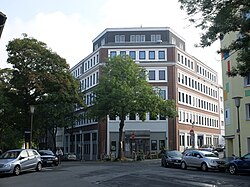Bochum office building
| Bochum office building since 1983: Fritz-Husemann-Haus |
|
|---|---|
 |
|
| Data | |
| place | Bochum |
| architect | unknown |
| Architectural style | New Objectivity |
| Construction year | 1925 |
The Bochum office building is an office and commercial building in the North Rhine-Westphalian city of Bochum . It was built in 1925 in the Ehrenfeld district on the corner plot of Hattinger Straße 19 (today Alte Hattinger Straße 19) / Clemensstraße near the main train station at the time (formerly Bergisch-Märkischer Bahnhof or Bochum Süd train station).
history
The office building is one of the first buildings of this type in Bochum and is stylistically assigned to the New Objectivity or New Building . The facades are kept simple and are merely structured by cornices in contrasting colors . There were originally shops with shop windows on the ground floor.
The height of the building was effectively staggered in terms of urban planning : at the ends it was four-and-a-half-storey in line with the older neighboring buildings, the top storey with dormers turned into a full storey at the corner, and the corner wing itself was raised like a tower with a sixth storey. Such an emphasis on the building corners at a street crossing was already common in the architecture of historicism (and in earlier epochs), but this design also testifies to the contemporary urge for the high-rise building type as the epitome of modernity and the economic boom after the inflationary period .
At the building is "a neon sign system for the first time with the current news and advertising texts in the Ruhr area" have been installed.
After severe bomb damage in the Second World War, a simplified reconstruction took place, whereby the six-storey corner wing with the cornice-like tower reminiscent of the architecture of Expressionism lost its “crown”. During further renovations after 1950, the shops were abandoned and the fourth floor was given a uniform height and rectangular windows. The office building, which is not under monument protection, has been named Fritz-Husemann-Haus since 1983 - in memory of the chairman of the Association of Mining Industry Workers in Germany and SPD Reichstag member Fritz Husemann , who worked there and was murdered by the National Socialists in 1935. A plaque commemorates him.
use
Well-known tenants in the early days were the "Flora Drogerie" or later an Opel agency and the Association of Mining Industry Workers in Germany . In 1946 the building was used by the newly established Mining Industry Association, which was renamed IG Bergbau in 1948. Since 1960 this union was called IG Bergbau und Energie . In 1997 it became part of the IG Bergbau, Chemie, Energie (IG BCE), whose regional district of Westphalia is still housed in the office building today, as is the office of the SPD and offices of the Education and Science Union (GEW). The union's own Berg-Verlag is also located here, which was located on the other side of Königsallee in the post-war years.
Individual evidence
- ^ Frank Dengler: The "Bochum office building". In: Ruhr-Nachrichten of September 10, 2014 ( online at www.ruhrnachrichten.de )
- ↑ Jürgen Boebers-Süßmann: In the style of the new objectivity. In: Westdeutsche Allgemeine Zeitung of April 24, 2016 ( online at www.derwesten.de )
- ↑ Florian Zimmermann (ed.): The cry for the tower house. Argon-Verlag, Berlin 1988, ISBN 3-87024-127-6 .
- ^ Association of German Architects , Ruhr Area District Group (Ed.): Building in Bochum. (= Architecture in the Ruhr area , Volume 4.) Schürmann & Klagges, Bochum 1986, ISBN 3-920612-32-9 , p. 87. (Here and elsewhere the building is erroneously dated to 1928–1930, but this is due to its mention in Bochum address book 1926 is to be refuted.)
Web links
literature
- Dietmar Bleidick, Dirk Ernesti: Historical field of honor. Bochum 2009.
Coordinates: 51 ° 28 '25.6 " N , 7 ° 12' 54.4" E